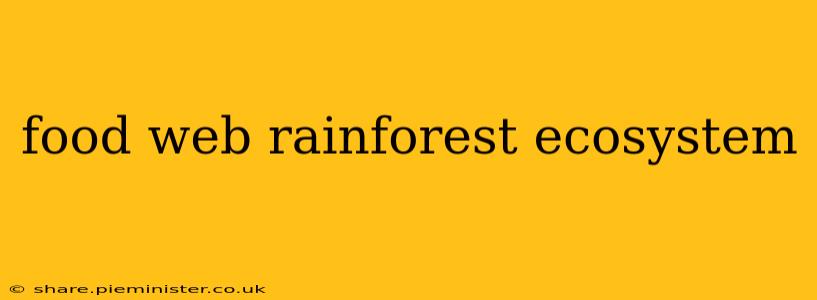Rainforests, the Earth's lungs, teem with biodiversity, creating a complex and fascinating food web. Understanding this intricate network is crucial to appreciating the delicate balance of these vital ecosystems and the consequences of disruption. This post delves into the rainforest food web, exploring its various trophic levels and the interdependencies that make it so unique.
What is a Rainforest Food Web?
A rainforest food web illustrates the feeding relationships between different organisms within a rainforest ecosystem. Unlike a simple food chain, which depicts a linear progression of energy transfer (e.g., grass → deer → lion), a food web shows the interconnectedness of multiple food chains. Organisms in a rainforest occupy various trophic levels, each playing a vital role in maintaining the overall ecosystem's health.
Key Components:
- Producers (Autotrophs): These are mainly plants, like trees, vines, and epiphytes, that produce their own food through photosynthesis. They form the base of the rainforest food web.
- Consumers (Heterotrophs): These organisms obtain energy by consuming other organisms. They are categorized into:
- Primary Consumers (Herbivores): These animals feed directly on producers. Examples include insects, monkeys, sloths, and various types of birds.
- Secondary Consumers (Carnivores): These animals prey on primary consumers. Examples include snakes, lizards, frogs, and small cats.
- Tertiary Consumers (Apex Predators): These are the top predators, often at the top of multiple food chains. Examples include jaguars, eagles, and anaconda snakes.
- Decomposers (Detritivores): These organisms, like fungi and bacteria, break down dead organic matter, returning essential nutrients to the soil, which in turn supports plant growth. They play a crucial role in nutrient cycling.
How Does Energy Flow Through the Rainforest Food Web?
Energy flows through the rainforest food web in a unidirectional manner, starting with the producers. Producers capture solar energy through photosynthesis and convert it into chemical energy stored in their tissues. Herbivores consume producers, gaining energy, and then carnivores consume herbivores, transferring energy up the food chain. At each level, some energy is lost as heat, explaining why fewer organisms exist at the higher trophic levels.
What are the Different Types of Rainforest Food Webs?
While a single, overarching food web describes the rainforest, various smaller, interconnected food webs exist within it. These can be categorized by habitat, such as the food web of the forest floor, the canopy, or the riverine system. Each micro-habitat supports unique plant and animal communities, contributing to the overall rainforest food web's complexity.
What are the main producers in a rainforest food web?
The main producers are a vast array of plants, including towering trees (like mahogany and kapok), epiphytes (plants growing on other plants, like orchids and bromeliads), vines, shrubs, and understory plants. Their diversity and abundance are critical for supporting the entire ecosystem.
What are some examples of herbivores in a rainforest food web?
Many herbivores inhabit rainforests, specializing in consuming different parts of plants. Examples include leaf-eating insects (like caterpillars and beetles), fruit-eating bats, monkeys that consume fruits and leaves, sloths that primarily feed on leaves, and various species of birds that consume nectar, seeds, and fruits.
What are some examples of carnivores in a rainforest food web?
Carnivores play a critical role in regulating populations of herbivores. Examples include snakes that prey on rodents and amphibians, predatory birds like eagles and hawks, jaguars hunting monkeys and other mammals, and various species of frogs and lizards that feed on insects.
What is the impact of deforestation on the rainforest food web?
Deforestation severely impacts the rainforest food web, often causing catastrophic consequences. Habitat loss directly reduces producer populations, leading to a decline in herbivores, subsequently affecting carnivores and ultimately disrupting the entire network. The loss of biodiversity weakens the ecosystem's resilience, making it more vulnerable to further disturbances.
How do decomposers contribute to the rainforest food web?
Decomposers are indispensable in recycling nutrients. They break down dead plants and animals, returning essential elements like nitrogen and phosphorus to the soil. These nutrients are then absorbed by plants, ensuring the continuous flow of energy through the food web. Without decomposers, the rainforest's fertility would dramatically decrease.
In conclusion, the rainforest food web is a marvel of ecological complexity, characterized by intricate interdependencies and remarkable biodiversity. Understanding this complex network highlights the fragility of these ecosystems and the urgent need for their conservation. The interconnectedness of life within a rainforest underscores the far-reaching consequences of any disruption, emphasizing the importance of preserving this vital resource for future generations.
